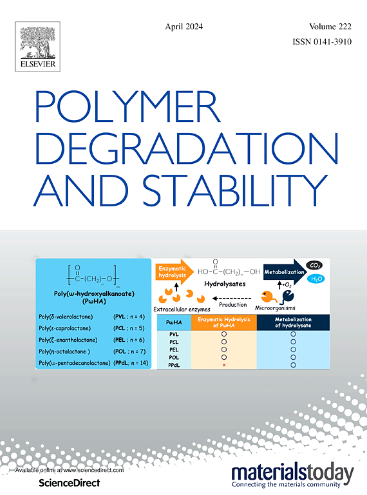One- and two-step synthesis of paramylon mixed ester derivatives and the substitution effect on mechanical properties and seawater biodegradability
IF 6.3
2区 化学
Q1 POLYMER SCIENCE
引用次数: 0
Abstract
Paramylon acetate hexanoate (PaAcHex) with total DS=1.7 was prepared by one- and two-step methods with acetylation and hexanoylation in different order (denoted as AcHex and HexAc) in homogeneous DMAc/LiCl. The distribution of substitution at various ring carbon atoms (C2, C4, and C6) of PaAcHex synthesized by different methods was determined by 1H NMR spectroscopic analysis. The AcHex mixed esters showed a higher DS of long-chain Hex on C2 and C4 than the other samples. All mixed esters were amorphous and their glass transition temperatures (Tg) were obtained from DMA measurements. PaAcHex with higher DS of hexanoate groups had lower Tg and their melt films showed higher flexibility at the same total DS for all three series of samples. PaAcHex films produced by the two-step (AcHex) method exhibited high toughness even with a low DS of hexanoate groups, whereas those synthesized by the one-step and two-step (HexAc) methods were weak and brittle. Biochemical oxygen demand tests indicated that the mixed esters prepared by the two-step (AcHex) method underwent a two-step degradation process, which may be related to the hexanoate groups on C2 and C4. Short–long chain acylation by the two-step (AcHex) method was found to be the optimal synthesis technique for polysaccharide esters that displayed favorable thermoplasticity and controllable seawater biodegradation behavior. These polysaccharide esters show promise as bioplastic materials.
巴龙混合酯衍生物的一步法和两步法合成及其对机械性能和海水生物降解性的影响
在均相 DMAc/LiCl 溶液中,采用乙酰化和己酰化不同顺序的一步法和两步法(分别称为 AcHex 和 HexAc)制备了总 DS=1.7 的乙酰己酸帕拉米隆(PaAcHex)。通过 1H NMR 光谱分析确定了不同方法合成的 PaAcHex 在不同环碳原子(C2、C4 和 C6)上的取代分布。与其他样品相比,AcHex 混合酯在 C2 和 C4 上显示出更高的长链 Hex DS。所有混合酯都是无定形的,其玻璃化转变温度(Tg)是通过 DMA 测量得到的。在所有三个系列的样品中,己酸基团含量较高的 PaAcHex 具有较低的 Tg,在总含量相同的情况下,其熔融薄膜显示出更高的柔韧性。采用两步法(AcHex)生产的 PaAcHex 薄膜即使己酸基团含量较低,也表现出较高的韧性,而采用一步法和两步法(HexAc)合成的薄膜则较薄且脆。生化需氧量测试表明,两步法(AcHex)制备的混合酯经历了两步降解过程,这可能与 C2 和 C4 上的己酸基团有关。研究发现,采用两步法(AcHex)进行短长链酰化是合成多糖酯的最佳技术,这些多糖酯具有良好的热塑性和可控的海水生物降解行为。这些多糖酯有望成为生物塑料材料。
本文章由计算机程序翻译,如有差异,请以英文原文为准。
求助全文
约1分钟内获得全文
求助全文
来源期刊

Polymer Degradation and Stability
化学-高分子科学
CiteScore
10.10
自引率
10.20%
发文量
325
审稿时长
23 days
期刊介绍:
Polymer Degradation and Stability deals with the degradation reactions and their control which are a major preoccupation of practitioners of the many and diverse aspects of modern polymer technology.
Deteriorative reactions occur during processing, when polymers are subjected to heat, oxygen and mechanical stress, and during the useful life of the materials when oxygen and sunlight are the most important degradative agencies. In more specialised applications, degradation may be induced by high energy radiation, ozone, atmospheric pollutants, mechanical stress, biological action, hydrolysis and many other influences. The mechanisms of these reactions and stabilisation processes must be understood if the technology and application of polymers are to continue to advance. The reporting of investigations of this kind is therefore a major function of this journal.
However there are also new developments in polymer technology in which degradation processes find positive applications. For example, photodegradable plastics are now available, the recycling of polymeric products will become increasingly important, degradation and combustion studies are involved in the definition of the fire hazards which are associated with polymeric materials and the microelectronics industry is vitally dependent upon polymer degradation in the manufacture of its circuitry. Polymer properties may also be improved by processes like curing and grafting, the chemistry of which can be closely related to that which causes physical deterioration in other circumstances.
 求助内容:
求助内容: 应助结果提醒方式:
应助结果提醒方式:


